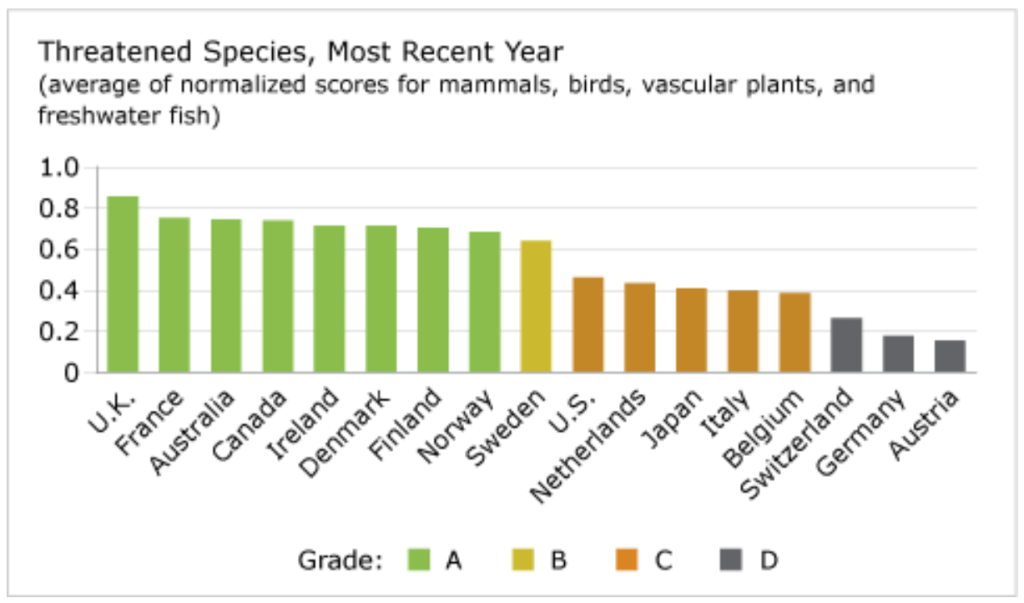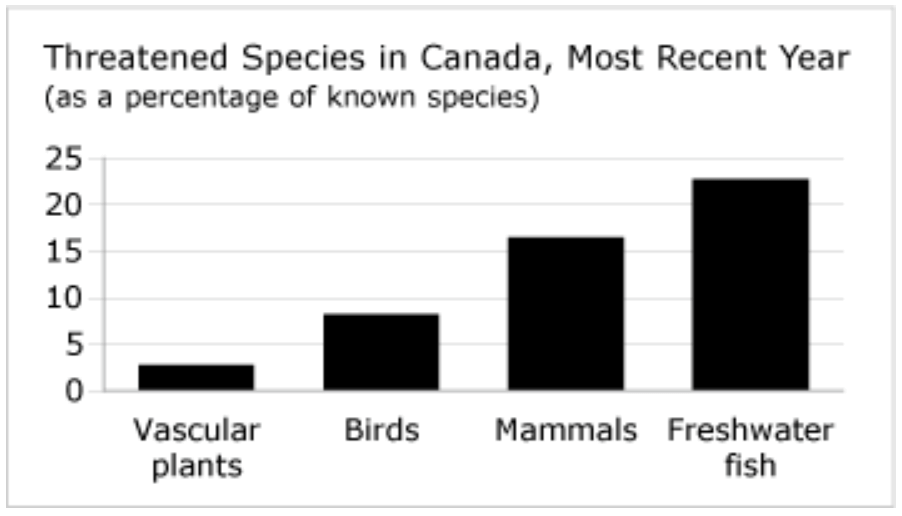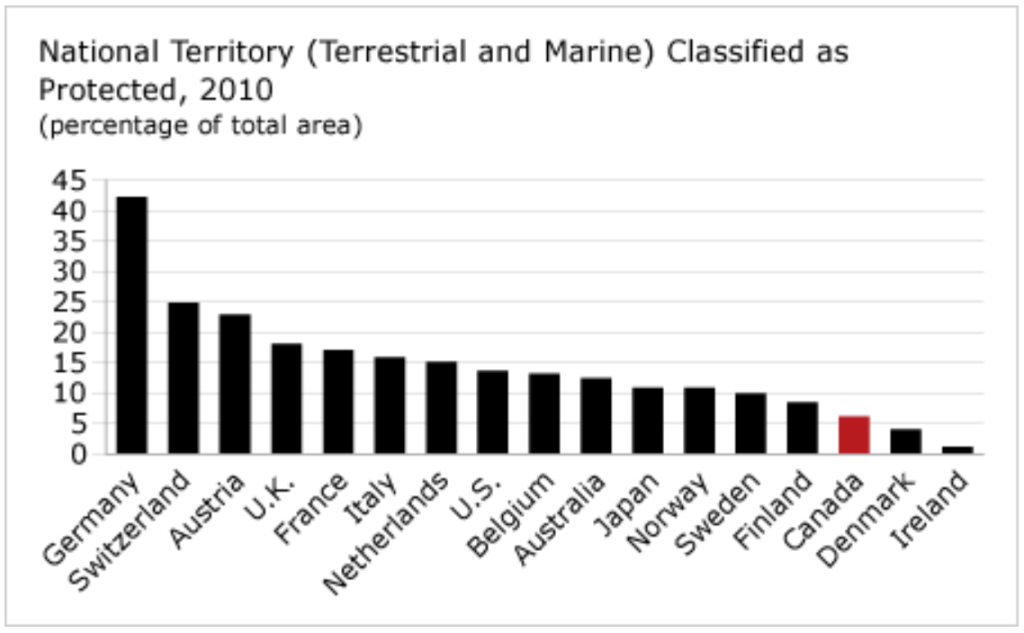Threatened Species
Key Messages
- Canada ranks 4th out of 17 peer countries and earns an “A” grade.
- The number of species at risk in Canada is increasing.
- Federal biodiversity action plans have been prepared for the agriculture and forestry sectors. The Species at Risk Act came into effect in 2003 to help protect species at risk.

Putting threatened species in context
Canada is rich in biodiversity and home to 71,500 known species. Up to an estimated 66,000 species may remain to be discovered.1 There are three categories of “at risk”:
- critically endangered: species facing an extremely high risk of extinction in the wild in the immediate future
- endangered: species facing a very high risk of extinction in the wild in the near future
- vulnerable: species facing a high risk of extinction in the wild in the medium-term future
Is Canada doing a good job of protecting biodiversity?
Canada ranks 4th out of 17 peer countries for the proportion of threatened species of mammals, birds, vascular plants, and freshwater fish.
Canada does relatively well when species at risk are measured as a proportion of all known species. But Canada’s abundant biodiversity means it is home to more species than many of its peer countries, helping to lower the proportion of those at risk among all known species in Canada.2
The U.K., France, and Australia are the top performers for this indicator. The U.S. receives a “C” grade, and three countries—Switzerland, Germany, and Austria—receive “D” grades.
Are species at risk increasing in Canada?
According to the OECD, the number of species at risk in Canada is increasing (partly because of increased assessment work). Meanwhile, the status of most previously assessed species at risk is unchanged or has deteriorated. Increasing pressures on biodiversity reflect population growth in major urban regions and corridors, air and water pollution, alien invasive species, intensive farming, and increasing timber harvests.

How does Canada measure species at risk?
In Canada, the Committee on the Status of Endangered Wildlife in Canada (COSEWIC) assesses the national status of wild species, subspecies, varieties, or other important units of biological diversity that are considered to be at risk in Canada. In 2012, COSEWIC identified 627 species at risk in various categories, including 287 endangered species, 161 threatened species, and 179 of special concern.
As COSEWIC studies an increased number of species, more species have been added to Canada’s endangered species list. In 1988, for example, 178 endangered species were listed. By 2001, the number of species identified as being at risk by COSEWIC was 364.3
What is Canada doing to conserve or restore biodiversity?
In 1992, Canada became the first industrialized nation to ratify the United Nations Convention on Biological Diversity.4 To fulfill the objectives of the convention, Canada released a biodiversity strategy in 1995, with three main objectives: the conservation of biodiversity, the sustainable use of biological resources, and the fair and equitable sharing of the benefits that result from the use of genetic resources. To achieve these objectives, Environment Canada’s Ecological Monitoring and Assessment Network made a list of priorities:
- develop information
- monitor trends in biodiversity
- control alien invasive species
- engage Canadians through biodiversity stewardship
The government also committed to creating federal biodiversity action plans for agriculture, education, fisheries, forestry, international cooperation, northern affairs, parks, and wildlife.
In 2003, the Species at Risk Act came into effect to protect species at risk and help their numbers recover. The Act provides for the legal protection and recovery of species considered at risk and found on federal lands or under federal jurisdiction, and also for the protection of critical habitat. Ecosystem protection has progressed in Canada, with a 40 per cent increase in total area (30 million hectares) under protection.5
Overall, about 6 per cent of Canada’s total area is subject to some level of protection—below the peer country average and below the 12 per cent unofficial (but internationally recognized) national target.

Is Canada making enough progress?
In June 2007, the Auditor General of Canada delivered a progress report on recommendations made to the Department of Fisheries and Oceans, the Department of the Environment, and Parks Canada in a 2001 audit. The 2007 progress report criticized the three departments for failing to sufficiently address species at risk in Canada. Of 228 species at risk identified as requiring recovery strategies in 2001, only 55 species had recovery strategies completed for them by 2007.6
But recovery actions—including everything from research, public awareness, and education, to control of human activities, protection of habitat, and the reintroduction of species—are successfully being undertaken by a number of government and non-governmental organizations. In the 1940s, for example, the whooping crane was on the verge of extinction, with only 20 in existence. Although the species remains endangered, recovery efforts by many Canadian and American partners have fostered an increase in the bird’s population. An estimated 237 whooping cranes are now thriving in Wood Buffalo National Park.7
Footnotes
1 Organisation for Economic Co-operation and Development, Environmental Performance Reviews: Canada (Paris: OECD, 2004), 76.
2 David Suzuki Foundation, The Maple Leaf in the OECD: Comparing Progress Toward Sustainability (Vancouver: David Suzuki Foundation, 2005), 29.
3 David R. Boyd, Canada vs. the OECD: An Environment Comparison, 2001 (accessed August 20, 2008).
4 Secretariat of the Convention on Biodiversity, (accessed August 20, 2008).
5 OECD, Environmental Performance Reviews: Canada (Paris: OECD, 2004), 80.
6 Office of the Auditor General of Canada, “Chapter 5—Ecosystems—Protection of Species at Risk,” 2008 March Status Report of the Commissioner of the Environment and Sustainable Development, March 6, 2008 (accessed September 18, 2008).
7 Office of the Auditor General of Canada, “Chapter 5—Ecosystems—Protection of Species at Risk,” 2008 March Status Report of the Commissioner of the Environment and Sustainable Development, March 6, 2008 (accessed September 18, 2008).

